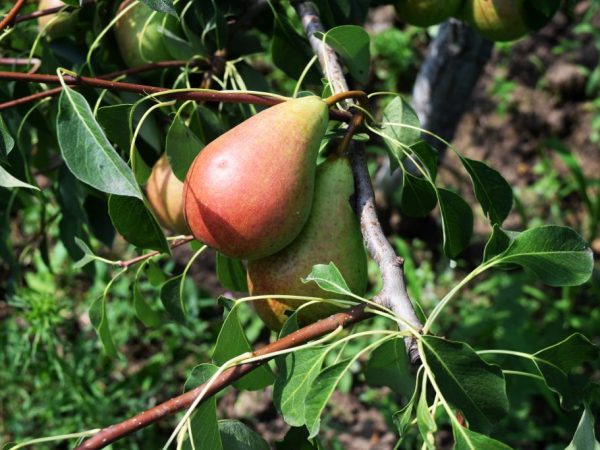Characteristics of the Kokinskaya pear variety
Pear Kokinskaya is an early hybrid autumn variety. It is the result of crossing Popular and Kure varieties.

Characteristics of the Kokinskaya pear variety
Characteristics of the variety
This fruit gained popularity due to the possibility of growing it on an industrial scale. The fruits can be stored in rooms with low temperatures for 2-3 months. The main thing is that the plucked fruits are intact.
Ripening begins 3 years after planting. A high yield is noted - about 100 kg per 1 m2.
Weather conditions do not become a big problem for trees. Not afraid of severe frosts and icing. At low temperatures, the buds can freeze, but the pear will still survive. The plant is characterized by resistance to diseases, especially scab.
The plant is unpretentious to the quality of the land. In addition to drainage soil, sandy loam, slightly acidic, soddy, medium podzolic, light loamy soils are suitable.
Trees of this type are considered self-fertile. That is, no additional pollinating plants are needed for the pollination process.
Description of the tree
According to the description, the Kokinskaya pear reaches a height of 4 m. The crown diameter is up to 2.5 m. The trunk is straight, the crown is not too dense. The leaves are rounded, deep green.
The plant needs regular pruning. The purpose of the procedure is to form a pyramid shape.
Description of fruits
The description shows that the fruit can weigh up to 250 grams. The pulp tastes sweet and sour, light and juicy. However, after several large harvests, the size of the fruit begins to decrease.
Fruit appearance:
- the stalk is strong and thick, slightly curved in shape;
- the color of the fruit can be green, after ripening - yellow, sometimes with a red barrel;
- well noticeable dots under the skin;
- wide pear-shaped fruit.
Kokinskaya pears are sweet, without sourness. There is no astringency in the taste.
Can be eaten fresh or in the form of jam and compotes. They also make jams, confitures, pastilles. Sometimes sweet wines or juices are made from them.
The fruits are hypoallergenic, therefore they are allowed for use by children from 6 months.
Care

Maintain the tree well
In order for the planted seedling to give a good harvest, it is important to worry about the planting site in advance. This variety is very picky about neighbors. It is better not to plant rowan next to it, because it and the Kokinskaya pear are affected by similar diseases and pests. An excellent solution is to plant a seedling near the apple tree.
Watering
Kokinskaya loves regular watering. Especially during the flowering period.
The best way is to simulate natural watering with sprayers. In this case, the soil around the crown is not clogged and the roots receive the required amount of oxygen and moisture.
Loosening
Loosening of the soil and weeding should be carried out 2-4 times during the summer. This will help the roots get oxygenated and eliminate weeds.
It is best to use a shovel or hoe for loosening. It is not necessary to immerse the instrument very deeply in the ground. This can damage the roots.
Mulching
It is carried out to improve the condition of the soil and control weeds. Mulching helps trap moisture around the trunk.
The best materials are straw, hay, freshly cut grass, finely crushed nettle, sawdust. Special bark for mulching trees and rotted needles are also suitable.
Top dressing
Fertilizer should be applied the next year after spring or autumn planting. They are fed with organic compounds and mineral fertilizers. The goal is to improve the condition of the soil.
It is necessary to fertilize the soil every year at least 2 times. Especially if the soil is of poor quality and the plant does not develop well.
Pruning
Formative pruning is performed to give the tree the correct shape. Sanitary - to get rid of dried and diseased branches or to reduce the weight of a branch with fruits.
Gardeners advise pruning in the spring - before the leaves have blossomed.
In order not to damage the plant, adhere to the following rules:
- no need to prune too many branches at one time;
- you cannot leave grooves and hemp on the branch, otherwise the cut site will dry out for a long time;
- branches should not be allowed to break, especially those large in diameter;
- after pruning, you need to process the cut so that the secreted juice does not attract insects.
You can prune in the fall. It is necessary to remove all dry, diseased branches growing inward.
But in summer and winter, it is better not to do pruning. The weather conditions during these seasons will not allow the saw cut to drag out, which will significantly weaken the plant.
Diseases
The Kokinskaya variety is resistant to diseases and pests. But improper care can cause scab and moniliosis.
To protect the tree from scab, it is important to moderately water and feed the seedling, gently loosen the ground around. Other preventive measures include removing weeds and removing fallen leaves in the fall.
The second disease affecting this variety is moniliosis or monilial burn. It is caused by the fungus Moniliafructigena. The fruits suffer from its effects. Therefore, it is important to remove the affected pears in time. It is necessary to carry out treatment with a 3% solution of boric liquid before flowering and after its end.
Conclusion
Kokinskaya pear variety is unpretentious in cultivation. Caring for it comes down to standard actions: feeding, cutting, mulching, watering, loosening. Pear fruits ripen in early autumn and tolerate storage and transportation well.


